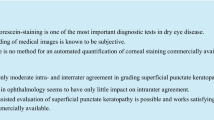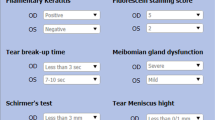Abstract
This article describes methods used to determine the severity of Dry Eye Syndrome (DES) based on Oxford Grading Schema (OGS) automatically by developing and applying a decider model. The number of dry punctate dots occurred on corneal surface after corneal fluorescein staining can be used as a diagnostic indicator of DES severity according to OGS; however, grading of DES severity exactly by carefully assessing these dots is a rather difficult task for humans. Taking into account that current methods are also subjectively dependent on the perception of the ophtalmologists coupled with the time and resource intensive requirements, enhanced diagnosis techniques would greatly contribute to clinical assessment of DES. Automated grading system proposed in this study utilizes image processing methods in order to provide more objective and reliable diagnostic results for DES. A total of 70 fluorescein-stained cornea images from 20 patients with mild, moderate, or severe DES (labeled by an ophthalmologist in the Keratoconus Center of Yildirim Beyazit University Ataturk Training and Research Hospital) used as the participants for the study. Correlations between the number of dry punctate dots and DES severity levels were determined. When automatically created scores and clinical scores were compared, the following measures were observed: Pearson’s correlation value between the two was 0.981; Lin’s Concordance Correlation Coefficients (CCC) was 0.980; and 95% confidence interval limites were 0.963 and 0.989. The automated DES grade was estimated from the regression fit and accordingly the unknown grade is calculated with the following formula: Gpred = 1.3244 log(Ndots) - 0.0612. The study has shown the viability and the utility of a highly successful automated DES diagnostic system based on OGS, which can be developed by working on the fluorescein-stained cornea images. Proper implemention of a computationally savvy and highly accurate classification system, can assist investigators to perform more objective and faster DES diagnoses in real-world scenerios.












Similar content being viewed by others
References
Sullivan, D.A., & Stern, M.E., & Tsubota, K., & Dartt, D.A., & Sullivan, R.M., & Bromberg, B.B., “Lacrimal Gland Tear Film, and Dry Eye Syndromes 3”. (1st ed.), Springer, (Part B), US, 2002.
Lemp, M. A., Basic principles and classifications of dry eye disorders, in: The Dry Eye: A comprehensive Guide. Berlin: Springer-Verlag, 1992.
Acharya, U.R., & Ng, E.Y.K., & Suri, J. S., & Campilho, A., (Eds.), Image Analysis and Modeling in Ophthalmology”, (1st ed.), CRC Press, 294–9, 2014.
Garcia, L.R., Advancing the diagnosis of Dry Eye Syndrome: development of dynamic, automated tear film Break-Up assessment. Thesis (PhD), Universidade Da Coruna, Facultade de Informatica, Departamento de Computacion, 2014.
Lin, H., and Yiu, S. C., Dry eye disease: A review of diagnostic approaches and treatments. Saudi Journal of Ophthalmology 28(3):173–181, 2014.
Asbell, P., & Lemp, M., Dry Eye Disease: The Clinician's Guide to Diagnosis and Treatment. (1st ed.). TNY, (Chapter 1), 2006.
Foulks, G. H., Lemp, M. A., Vester, J. V., Sutphin, J., Murube, J., and Novack, G. D., The definition and classification of dry eye disease: Report of the Definition and Classification Subcommittee of the International Dry Eye Workshop. The Ocular Surface 5:75–92, 2007.
Begley, C. G., Chalmers, R. L., Abetz, L., Venkataraman, K., Mertzanis, P., Caffery, B. A., Snyder, C., Edrington, T., Nelson, D., and Simpson, T., The relationship between habitual patient-reported symptoms and clinical signs among patients with dry eye of varying severity. Invest. Ophthalmol. Vis. Sci. 44:4753–4761, 2003.
Adatia, F. A., Michaeli-Cohen, A., Naor, J., Caffery, B., and Slomovic, A., Correlation between corneal sensitivity, subjective dry eye symptoms and corneal staining in Sjogren’s syndrome. Can. J. Ophthalmol. 39:767–771, 2004.
Vitale, S., & Goodman, L. A., & Reed, G. F., & Smith, J. A., Comparison of the NEI-VFQ and OSDI questionnaires in patients with Sjogren’s syndrome-related dry eye, Health and Quality of Life Outcomes, 2(44), 2004.
Liu, Z., and Pflugfelder, S. C., Corneal surface irregularity and the effect of artificial tears in aqueous tear deficiency. Ophthalmology 106(5):939–943, 1999.
Goto, E., Yagi, Y., Matsumoto, Y., and Tsubota, K., Impaired functional visual acuity of dry eye patients. Am J. Ophthalmol. 133(2):181–186, 2002.
Bron, A. J., Diagnosis of dry eye. Survey of Opthalmology, 221–6, 2001.
Goto, T., Zheng, X., Klyce, S. D., Kataoka, H., Uno, T., Karon, M., Tatematsu, Y., Bessyo, T., Tsubota, K., and Obashi, Y., A new method for tear film stability using videokeratography. Am J. Ophthalmol. 135(5):607–612, 2003.
Gilbard, J. P., Human tear film electrolyte concentrations in health and dry-eye disease. Int. Ophthalmol. Clin. 34(1):27–36, 1994.
Murube, J., Tear osmolarity. The Ocular Surface 4(2):62–73, 2006.
Tomlinson, A., Khanal, S., Ramaesh, K., Diaper, C., and McFadyen, A., Tear film osmolarity: determination of a referent for dry eye diagnosis. Invest. Ophthalmol. Vis. Sci. 47(10):4309–4315, 2006.
Tsubota, K., Fujihara, T., Saito, K., and Takeuchi, T., Conjunctival epithelium expression of HLA-DR in dry eye patients. Ophthalmologica 213(1):16–19, 1999.
Fenga, C., Aragona, P., Cacciola, A., Spinela, R., Nola, C. D., Ferreri, F., and Rania, L., Melbonian gland dysfunction and ocular discomform in video display terminal workers. Eye 22:91–95, 2008.
García-Resúa, C., Lira, M., and Yebra-Pimentel, E., Evaluacióon superficial en jóvenes universitarios. Rev. Esp. Contact 12:37–41, 2005.
Kaštelan, S., Tomić, M., Salopek-Rabatić, J., and Novak, B., Diagnostic Procedures and Management of Dry Eye. Biomed. Res. Int. 2013:1–6, 2013.
Tutt, R., Bradley, A., Begley, C., and Thibos, L. N., Optical and visual impact of tear break-up in human eyes. Invest. Ophthalmol. Vis. Sci. 41:4117–4123, 2000.
Stevenson, W., Chauhan, S., and Dana, R., Dry eye disease: an immunemediated ocular surface disorder. Arch. Ophthalmol. 130(1):90–100, 2012.
DEWS Reports, “Methodologies to diagnose and monitor dry eye disease: report of the Diagnostic Methodology Subcommittee of the International Dry Eye WorkShop pp. 108–52 [online]” http://www.tearfilm.org/dewsreport/pdfs/TOS-0502-DEWS-noAds.pdf
Bron, A. J., The Doyne Lecture. Reflections on the tears. Eye (Lond) 11:583–602, 1997.
Bron, A., Evans, V. E., and Smith, J. A., Grading of corneal and conjunctival staining in the context of other dry eye tests. Cornea 22(7):640–650, 2003.
King-Smith, P. E., Fink, B. A., and Fogt, N., Three interferometric methods for measuring the thickness of layers of the tear film. Optom. Vis. Sci. 76(1):19–32, 1999.
Goto, E., Dogru, M., Kojima, T., and Tsubota, K., Computer-synthesis of an interference color chart of human tear lipid layer, by a colorimetric approach. Invest. Ophthalmol. Vis. Sci. 44(11):4693–4697, 2003.
Remeseiro, B., Ramos, L., Penas, M., Martínez, E., Penedo, M., and Mosquera, A., Colour texture analysis for classifying the tear film lipid layer: a comparative study. International Conference on Digital Image Computing: Techniques and Applications (DICTA):268–273, 2011.
Remeseiro, B., Bolon-Canedo, V., Peteiro-Barral, D., Alonso-Betanzos, A., Guijarro-Berdinas, B., Mosquera, A., Penedo, M. G., and Sáanchez-Maroño, N., A Methodology for Improving Tear Film Lipid Layer Classification. IEEE Journal of Biomedical and Health Informatics 18(4):1485–1493, 2014.
Remeseiro, B., & Mosquera, A., & Gonzalez Penedo, M., CASDES: a computer-aided system to support dry eye diagnosis based on tear film maps, Journal of Biomedical and Health Informatics, 1(1), 2015.
Rodriguez, J. D., Lane, K. J., Ousler, G. W., Angjeli, E., Smith, L. M., and Abelson, M. B., Automated grading system for evaluation of superficial punctate keratitis associated with dry eye. Invest. Ophthalmol. Vis. Sci. 56:2340–2347, 2015.
Arslan, A., & Şen, B., & Delen, D., & Uysal, B. S., & Çelebi, F. V., & Çakmak, H. B., “A Computer-Aided Grading System for Clinical Evaluation of Dry Eye Syndrome”, Proceedings of the Global Conference on Healthcare Systems Engineering and Management 2016, Istanbul, Turkey, 2016.
Remeseiro, B., Ramos, L., Barreira, N., Mosquera, A., and Yebra-Pimentel, E., Colour Texture Segmentation of Tear Film Lipid Layer Images. LNCS: Computer Aided Systems Theory, Revised Selected Papers EUROCAST 2013(8112):140–147, 2013.
Ramos, L., Barreira, N., Mosquera, A., Penedo, M. G., Yebra-Pimentel, E., and Garcíıa-Resúa, C., Analysis of parameters for the automatic computation of the tear film Break-Up Time test based on CCLRU standards. Comput. Methods Prog. Biomed. 113(3):715–724, 2014.
Chun, Y. S., Yoon, W. B., Kim, K. G., and Park, I. K., Objective Assessment of Corneal Staining Using Digital Image Analysis. Invest. Ophthalmol. Vis. Sci. 55(12):7896–7903, 2014.
Acharya, U. R., Tan, J. H., Koh, J. E. W., and Tong, L., Automated Diagnosis of Dry eye using Infrared Thermography Images. Infrared Phys. Technol. 71:263–271, 2015.
Remeseiro, B., & Mosquera, A., Penedo, M., & García-Resúa, C., Tear film maps based on the lipid interference patterns, 6th International Conference on Agents and Artificial Intelligence (ICAART), France, 732–9. 2014.
Wu, D., Boyer, K. L., Nichols, J. J., and King-Smith, P. E., Texture based prelens tear film segmentation in interferometry images. Mach. Vis. Appl. 21:253–259, 2010.
Arslan, A., & Şen, B., & Çelebi, F.Ç., & Sertbaş, S. Automatic segmentation of region of interest for dry eye disease diagnosis system. Signal Processing and Communications Applications Conference, SIU, Zonguldak, 2016.
Mohamed, M. A., Abou-El-Soud, M. A., and Eid, M. M., Iris Detection and Normalization in Image Domain Based on Morphological Features. IJCSI International Journal of Computer Science Issues 11(1):51–59, 2014.
Labati, R. D., and Scotti, F., Noisy iris segmentation with boundary regularization and reflections removal. Image Vis. Comput. 28:270–277, 2010.
Gonzales, R. C., & Woods, R. E., & Eddins, S. L., Digital Image Processing Using Matlab. (2n ed.). Gatesmark, (Chapter 9), 2009.
Iverson, J., Kamath, C., and Karypis, G., Evaluation of connected component labeling algorithms for distributed-memory systems. Parallel Comput. 44:53–68, 2015.
Altman, D. G., and Bland, J. M., Measurement in medicine: the analysis of method comparison studies. Statistician 32:307–317, 1983.
Efron, N., Morgan, P. B., and Katsara, S. S., Validation of grading scales for contact lens complications. Ophthalmic Physiol. Opt. 21:17–29, 2001.
Efron, N., Grading scales for contact lens complications. Ophthalmic Physiol. Opt. 18:182–186, 1998.
Rodriguez, J. D., Johnston, P. R., Ousler, G. W., Smith, L. M., and Abelson, M. B., Automated grading system for evaluation of ocular redness associated with dry eye. Journal of Clinical Ophthalmology 7:1–8, 2013.
Yoneda, T., Sumi, T., and Takahashi, A., Automated hyperemia software analysis: reliability and reproducibility in healthy subjects. Jpn. J. Ophthalmol. 56:1–7, 2012.
Fieguth, P., and Simpson, T., Automated measurement of bulbar Redness. Invest. Ophthalmol. Vis. Sci. 43:340–347, 2002.
Papas, E. B., Key factors in the subjective and objective assessment of conjunctival erythema. Invest. Ophthalmol. Vis. Sci. 41:687–691, 2000.
Author information
Authors and Affiliations
Corresponding author
Ethics declarations
Ethical approval
All procedures performed in studies involving human participants were in accordance with the ethical standards of the institutional and/or national research committee and with the 1964 Helsinki declaration and its later amendments or comparable ethical standards.” (26,379,996/218, 15.11.2017, Yildirim Beyazit University, Ankara).
Additional information
This article is part of the Topical Collection on Image & Signal Processing
Rights and permissions
About this article
Cite this article
Bağbaba, A., Şen, B., Delen, D. et al. An Automated Grading and Diagnosis System for Evaluation of Dry Eye Syndrome. J Med Syst 42, 227 (2018). https://doi.org/10.1007/s10916-018-1086-3
Received:
Accepted:
Published:
DOI: https://doi.org/10.1007/s10916-018-1086-3




